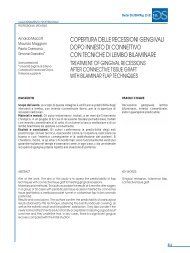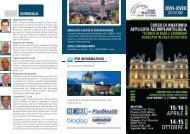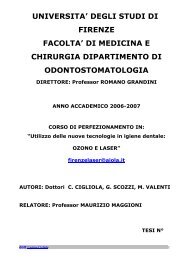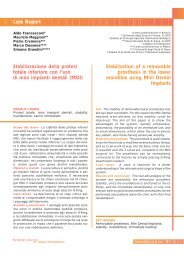LASER E SBIANCAMENTO - Maurizio Maggioni
LASER E SBIANCAMENTO - Maurizio Maggioni
LASER E SBIANCAMENTO - Maurizio Maggioni
Create successful ePaper yourself
Turn your PDF publications into a flip-book with our unique Google optimized e-Paper software.
RESULTS: The sites treated with ERL demonstrated mean CAL change from 6.3 +/- 1.1 mm to<br />
4.5 +/- 0.4 mm (P < 0.001) and to 4.9 +/- 0.4 mm (P < 0.001) at 1 and 2 years, respectively.<br />
No statistically significant differences were found between the CAL mean at 1 and 2 years<br />
postoperatively. The sites treated with SRP showed a mean CAL change from 6.5 +/- 1.0 mm to<br />
5.6 +/- 0.4 mm (P < 0.001) and to 5.8 +/- 0.4 mm (P < 0.001) at 1 and 2 years, respectively.<br />
The CAL change between 1 and 2 years did not present statistically significant differences. Both<br />
groups showed a significant increase of cocci and non-motile rods and a decrease in the amount of<br />
spirochetes. However, at the 1- and 2-year examination, the statistical analysis showed a<br />
significant difference for the CAL (P < 0.001, respectively) between the 2 treatment groups.<br />
CONCLUSION: It was concluded that the CAL gain obtained following non-surgical periodontal<br />
treatment with ERL or SRP can be maintained over a 2-year period.<br />
Clinical evaluation of an Er:YAG laser for nonsurgical<br />
treatment of peri-implantitis: a pilot study.<br />
Schwarz F, Sculean A, Rothamel D, Schwenzer K, Georg T, Becker J.<br />
Department of Oral Surgery, Heinrich Heine University, Westdeutsche Kieferklinik, D-40225<br />
Dusseldorf, Germany. info@frank-schwarz.de 2005<br />
The aim of this controlled, parallel design clinical study was to compare the effectiveness of an<br />
Er:YAG laser (ERL) to that of mechanical debridement using plastic curettes and antiseptic therapy<br />
for nonsurgical treatment of peri-implantitis. Twenty patients with moderate to advanced periimplantitis<br />
lesions were randomly treated with either (1) an ERL using a cone-shaped glass fiber<br />
tip at an energy setting of 100 mJ/pulse and 10 pps (ERL), or (2) mechanical debridement using<br />
plastic curettes and antiseptic therapy with chlorhexidine digluconate (0.2%) (C). The following<br />
clinical parameters were measured at baseline, 3 and 6 months after treatment by one blinded<br />
and calibrated examiner: Plaque index (PI), bleeding on probing (BOP), probing depth (PD),<br />
gingival recession (GR) and clinical attachment level (CAL). At the baseline examination, there<br />
were no statistically significant differences in any of the investigated parameters. Mean value of<br />
BOP decreased in the ERL group from 83% at baseline to 31% after 6 months (P < 0.001) and in<br />
the C group from 80% at baseline to 58% after 6 months (P < 0.001). The difference between the<br />
two groups was statistically significant (P < 0.001, respectively). The sites treated with ERL<br />
demonstrated a mean CAL change from 5.8 +/- 1 mm at baseline to 5.1 +/- 1.1 mm (P < 0.01)<br />
after 6 months. The C sites demonstrated a mean CAL change from 6.2 +/- 1.5 mm at baseline to<br />
5.6 +/- 1.6 mm (P < 0.001) after 6 months. After 6 months, the difference between the two<br />
groups was statistically not significant (P > 0.05). Within the limits of the present study, it was<br />
concluded that (i) at 6 months following treatment both therapies led to significant improvements<br />
of the investigated clinical parameters, and (ii) ERL resulted in a statistically significant higher<br />
reduction of BOP than C.<br />
------------------------------------------------------------------------------------------<br />
frank schwarz<br />
Influence of an erbium, chromium-doped yttrium, scandium,<br />
gallium, and garnet (Er,Cr:YSGG) laser on the reestablishment<br />
of the biocompatibility of contaminated titanium implant<br />
surfaces.<br />
Schwarz F, Nuesry E, Bieling K, Herten M, Becker J.<br />
Department of Oral Surgery, Heinrich Heine University, Dusseldorf, Germany. info@frankschwarz.de<br />
BACKGROUND: The aim of the present study was to evaluate the influence of an erbium,<br />
chromium-doped yttrium, scandium, gallium, and garnet (Er,Cr:YSGG laser [ERCL]) on 1) the<br />
dott Cosimo Cigliola 154






